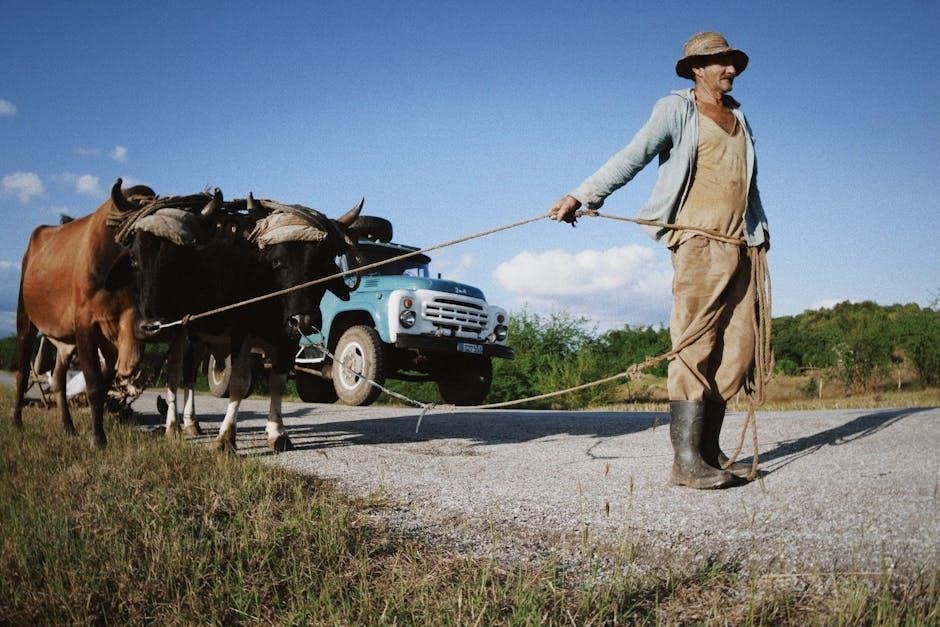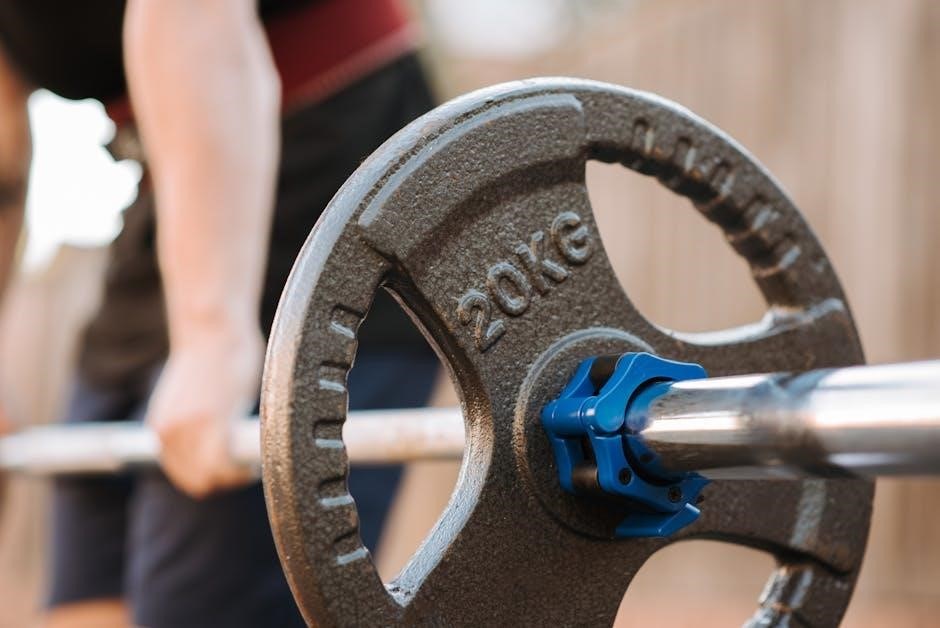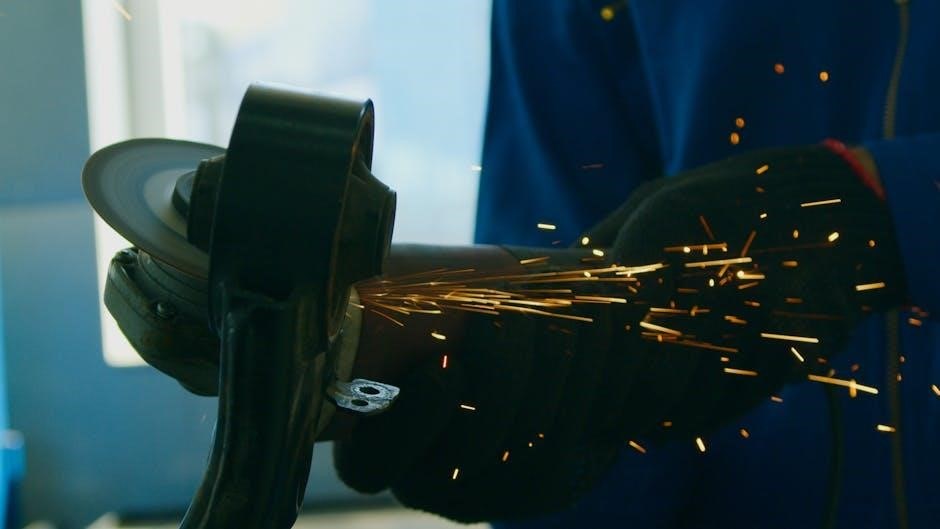Welcome to the Blue Ox Weight Distribution Hitch Manual. This guide provides essential information for safe installation, proper use, and maintenance of your hitch system. It ensures optimal performance and safety while towing. By following these instructions, you’ll achieve a balanced and stable towing experience.
Overview of the Blue Ox Weight Distribution Hitch
The Blue Ox Weight Distribution Hitch is a premium towing solution designed to enhance stability and control while hauling trailers. It effectively distributes weight, reducing sway and ensuring a level ride. With integrated points of friction and a robust design, it provides superior performance and safety. The hitch is engineered to handle maximum tongue weight capacities, making it suitable for various towing needs. Its innovative features and durability ensure a reliable towing experience, backed by comprehensive installation and maintenance guidelines in this manual.
Importance of Following the Manual
Following the Blue Ox Weight Distribution Hitch Manual is crucial for ensuring safe and effective use of your hitch system. Proper installation and maintenance procedures outlined in the manual prevent potential hazards and ensure optimal performance. Failure to adhere to the guidelines can lead to unsafe towing conditions, damage to your vehicle or trailer, or even accidents. The manual provides detailed instructions tailored to your specific hitch model, maximizing its efficiency and longevity. Always refer to the manual before making any adjustments or repairs to guarantee a secure and reliable towing experience.

Key Features of the Blue Ox Weight Distribution Hitch
The Blue Ox Weight Distribution Hitch is designed to enhance towing stability and safety. It features integrated points of friction for reduced sway, ensuring a smooth ride. With a maximum tongue weight capacity, it supports heavy trailers securely. The hitch system includes spring bars for optimal weight distribution, preventing trailer sag and promoting even load balance. Its durable construction and precise engineering make it a reliable choice for towing large trailers safely and efficiently.
Weight Distribution and Sway Prevention
The Blue Ox Weight Distribution Hitch is engineered to evenly distribute trailer weight, preventing sag and enhancing stability. Its advanced design incorporates four integrated points of friction, which work together to minimize trailer sway and promote a smooth towing experience. By balancing the load, the hitch ensures that both the tow vehicle and trailer remain level, improving control and safety on the road. This system is particularly effective for larger trailers, providing consistent performance and reducing the risk of sway-related incidents during transit.

Integrated Points of Friction for Stability
The Blue Ox Weight Distribution Hitch features four integrated points of friction, designed to enhance stability and control during towing. These points work together to distribute the trailer’s weight evenly, reducing the risk of sway and ensuring a smooth ride. By maintaining consistent contact and friction, the system prevents sudden movements, keeping the trailer aligned with the tow vehicle. This innovative design ensures optimal stability, making it easier to handle larger or heavier trailers with confidence and precision on the road.
Maximum Tongue Weight Capacity
The Blue Ox Weight Distribution Hitch is designed to handle a maximum tongue weight capacity of up to 350 pounds, ensuring it can support a wide range of trailers. Properly distributing this weight is crucial for maintaining control and stability while towing. Always refer to your specific model’s manual to confirm its capacity and ensure your setup adheres to these limits for safe and efficient towing. Exceeding this capacity can lead to reduced performance or safety risks, so adherence to guidelines is essential for optimal functionality. This feature ensures reliable performance across various towing needs.

Pre-Installation Checklist
Ensure understanding of tongue weight and trailer capacity, select the correct hitch ball height, and prepare both the towing vehicle and trailer for safe installation.
Understanding Tongue Weight and Trailer Capacity
Accurately determining tongue weight and trailer capacity is crucial for safe towing. Tongue weight refers to the downward force exerted by the trailer on the hitch, typically ranging from 10% to 15% of the trailer’s total weight. Exceeding the maximum tongue weight capacity can compromise stability and safety. Always refer to the owner’s manual for specific ratings and ensure your setup adheres to the manufacturer’s guidelines. Proper understanding prevents overload issues and ensures optimal hitch performance. Ignoring these limits can lead to unsafe towing conditions and potential damage to your equipment.
Choosing the Right Hitch Ball Height
Selecting the correct hitch ball height is essential for proper trailer alignment and towing stability. Measure from the ground to the top of the trailer coupler when the trailer is unloaded. The hitch ball height should match this measurement to ensure a level connection. Refer to your Blue Ox manual for specific guidelines, as incorrect height can lead to reduced stability and increased risk of trailer sway. Always verify the recommended height in the manual to ensure safe and efficient towing performance. Proper alignment is critical for optimal weight distribution and control during transit.
Preparing the Towing Vehicle and Trailer
Before installation, ensure both the towing vehicle and trailer are ready. Inspect the vehicle’s suspension and brake systems to confirm they can handle the trailer’s weight. Check the trailer’s tires, brakes, and lighting to ensure they are in good working condition. Load the trailer evenly, securing all cargo properly. Lower the trailer onto the towing vehicle’s hitch ball, ensuring it is coupled correctly. Attach safety chains and connect the electrical wiring for lighting and brakes. Double-check all connections and test the brakes to ensure everything functions smoothly. Refer to the Blue Ox manual for specific preparation guidelines to ensure a safe setup.

Installation Instructions
Begin by mounting the hitch head and receiver to the towing vehicle, ensuring a secure fit. Attach frame brackets to the trailer according to the manual’s specifications. Secure the hitch head to the tow vehicle, following the provided instructions for proper alignment. Measure and adjust the hitch ball height to match the trailer’s coupler. Attach the trailer coupler to the hitch ball and ensure all connections are tight. Double-check the setup for stability and safety before towing.
Mounting the Hitch Head and Receiver
Mounting the hitch head and receiver begins with assembling the components and securing them to the towing vehicle. Follow the manual’s torque specifications to ensure a tight fit. Align the hitch ball height with the trailer’s coupler for proper weight distribution. Once aligned, attach the trailer coupler to the hitch ball and secure all connections tightly. Double-check the setup for stability and safety before towing. Proper mounting ensures a secure and balanced connection, essential for safe and efficient towing.
Attaching Frame Brackets to the Trailer
Attach the frame brackets to the trailer by positioning them securely on the trailer frame. Use the provided clamps or bolts to ensure a snug fit. Measure and align the brackets to ensure proper spacing and alignment with the hitch head. Tighten all hardware according to the manual’s torque specifications. Proper installation ensures the weight distribution system functions effectively and prevents excessive movement. Regularly inspect the brackets for wear or looseness. Follow the manual’s instructions for optimal performance and safety.
Securing the Hitch Head to the Tow Vehicle
Attach the hitch head to the tow vehicle by installing the hitch head/receiver assembly into the towing vehicle’s receiver tube. Secure it with the provided 5/8″ pin and clip. Tighten the locking mechanism to prevent movement. Ensure the hitch head is properly aligned with the trailer coupler. Refer to the manual for torque specifications when tightening bolts. Regular inspections are crucial to maintain safety. Properly securing the hitch head ensures stability and prevents detachment while towing. Always follow the manufacturer’s instructions for a safe and reliable connection.

Setting Up the Weight Distribution System
Install the hitch head and attach frame brackets to the trailer. Measure and adjust the hitch ball height to ensure proper alignment and leveling for stability.
Measuring and Adjusting the Hitch Ball Height
Proper hitch ball height is crucial for safe towing. Measure the trailer’s coupler height when loaded and ensure it matches the hitch ball height. Adjust the ball mount to achieve level alignment between the towing vehicle and trailer. Incorrect height can cause instability or damage. Always refer to the Blue Ox manual for specific instructions and torque specifications to ensure a secure connection and optimal performance during towing.
Installing Spring Bars for Weight Distribution
Spring bars are essential for distributing weight evenly between the towing vehicle and trailer. Attach the spring bars to the hitch head, ensuring they are securely fastened with the provided hardware. Next, connect the chains to the trailer frame brackets, tightening them evenly to distribute weight properly. Refer to the Blue Ox manual for specific torque specifications and chain tension guidelines. Proper installation ensures improved stability, reduces sway, and enhances overall towing performance. Always double-check the setup before towing to ensure safety and optimal weight distribution.
Ensuring Proper Alignment and Leveling
Proper alignment and leveling are critical for safe and effective towing. Measure the distance from the ground to the towing vehicle’s receiver and adjust the hitch ball height accordingly. Use a carpenter’s level to ensure the trailer and towing vehicle are level when connected. Tighten all connections firmly after adjustments. Regularly check alignment and leveling to maintain even weight distribution. Proper alignment prevents uneven weight distribution, which can lead to poor handling and safety risks. Always refer to the Blue Ox manual for specific leveling guidelines to ensure a stable and secure towing experience.

Maintenance and Inspection
Regularly inspect the hitch for wear, rust, and loose connections. Lubricate moving parts annually to ensure smooth operation. Store the hitch in a dry place when not in use to prevent rust and damage. Always check for proper alignment and tightening of all components before and after each use. Follow the Blue Ox manual’s maintenance schedule to extend the hitch’s lifespan and ensure reliable performance.
Regular Checks for Wear and Tear
Regular inspections are crucial to ensure the hitch’s optimal performance. Check the frame brackets for tightness and signs of wear. Inspect the spring bars for bending or cracks. Look for rust on all metal components and lubricate moving parts annually. Verify that all bolts and nuts are properly tightened. Examine the hitch ball and coupler for excessive wear or damage. Address any issues promptly to prevent system failure. Always refer to the Blue Ox manual for specific inspection guidelines to maintain safety and reliability during towing operations.
Lubricating Moving Parts
Regular lubrication of moving parts is essential for smooth operation. Apply a high-quality grease to the hitch ball, spring bars, and all pivot points annually. Use marine-grade or high-temperature grease for durability. Wipe off excess lubricant to avoid attracting dirt. Lubricate after cleaning and drying the parts. This prevents rust and ensures optimal performance. Refer to the manual for specific lubrication points and recommendations. Proper lubrication enhances safety and extends the hitch’s lifespan, ensuring reliable towing experiences. Always follow the manufacturer’s guidelines for the best results.
Storing the Hitch When Not in Use
Proper storage of the Blue Ox Weight Distribution Hitch ensures longevity and reliability. Clean and dry all components thoroughly before storage to prevent rust. Store the hitch in a cool, dry place, away from direct sunlight and moisture. Apply a thin layer of rust-inhibiting oil to metal parts. If storing for an extended period, consider covering the hitch to protect it from dust and UV exposure. Always refer to the manual for specific storage recommendations to maintain your hitch’s optimal condition and performance for future use.

Troubleshooting Common Issues
Troubleshooting common issues with your Blue Ox hitch? This section addresses trailer sway, noise, and alignment problems, ensuring safe and efficient towing. Refer to your manual for detailed solutions.
Addressing Trailer Sway Problems
Trailer sway can compromise safety and control while towing. To address this, ensure proper weight distribution and adjust the hitch setup as outlined in the manual. Check that spring bars are securely attached and friction points are properly adjusted. Inspect for worn or damaged components and replace them if necessary. Avoid sudden steering movements and maintain a steady speed; If sway persists, consult the troubleshooting section or contact Blue Ox support for assistance.
Resolving Noise or Vibration Issues
Noise or vibration issues with your Blue Ox hitch can often be resolved by ensuring proper installation and maintenance. Check that all bolts and nuts are tightened to the specified torque ratings. Lubricate moving parts, such as the hitch ball and spring bar connections, to reduce friction and eliminate noise. Inspect for worn or loose components and replace them as needed. If vibrations persist, verify that the hitch is properly aligned with the trailer and tow vehicle. Refer to the manual for detailed troubleshooting steps to ensure smooth operation.
Fixing Hitch Head Alignment Problems
Proper alignment of the hitch head is crucial for safe and stable towing. If misaligned, it can cause uneven weight distribution and trailer sway. To fix this, ensure the hitch ball height matches the trailer coupler height when the trailer is loaded. Verify that the spring bars are correctly positioned and secured. Tighten all bolts to the specified torque ratings. If issues persist, consult the manual for detailed adjustment instructions. Proper alignment ensures optimal performance and safety while towing with your Blue Ox hitch system.

Safety Guidelines
Always follow the manual’s instructions and manufacturer specifications. Ensure all components are securely fastened and inspect for wear before use. Never exceed weight limits. Regular maintenance ensures safe towing.
Pre-Tow Safety Checks
Before every towing trip, conduct a thorough pre-tow inspection. Check the hitch head, spring bars, and frame brackets for wear or damage. Ensure all bolts are tightened to the specified torque. Verify the hitch ball height matches your trailer’s coupler height and that the tongue weight is within the recommended range. Test the brake system and ensure all lights function properly. Always secure the trailer to the tow vehicle with safety chains and follow the manual’s guidelines for weight distribution. A pre-tow checklist helps prevent accidents and ensures a safe towing experience.
Best Practices for Towing
Always maintain a steady speed and avoid sudden acceleration or braking. Keep a safe distance from other vehicles and stay alert to surroundings. Ensure proper weight distribution and balance before towing. Monitor the trailer’s position through mirrors and periodic checks. Use brakes gradually and evenly, especially on inclines. Avoid sharp turns or sudden maneuvers that could cause trailer sway. Regularly inspect the hitch and connections during long trips. Stay informed about weather and road conditions. Follow all traffic laws and never exceed the hitch’s weight capacity. Safe towing practices ensure a secure and enjoyable journey.
Emergency Procedures
In case of an emergency while towing, remain calm and follow these steps. If the trailer begins to sway, gently steer straight and reduce speed gradually. Avoid sudden braking, as this can worsen instability. If the hitch fails, pull over safely and secure the trailer. Never attempt to repair the hitch while towing. In case of a breakdown, turn on hazard lights and call for professional assistance. Always keep emergency contact numbers handy. Regularly review this manual to prevent emergencies and ensure safe towing practices; Your safety is the top priority.

Blue Ox Product Line and Accessories
Blue Ox offers a range of weight distribution hitches, including the TrackPro and SwayPro models, designed for optimal towing performance. Accessories like hitch balls, frame brackets, and spring bars enhance functionality and safety, ensuring a secure and stable towing experience.
Overview of Blue Ox Hitch Models
Blue Ox offers a variety of weight distribution hitch models, including the TrackPro and SwayPro, designed for different towing needs. The TrackPro is known for its revolutionary design, combining weight distribution with sway prevention, while the SwayPro excels in reducing trailer sway and ensuring a balanced load. These models are built for durability and performance, catering to both heavy-duty and everyday towing requirements. With integrated points of friction and maximum tongue weight capacities, Blue Ox hitches provide reliability and versatility for a secure towing experience.
Recommended Accessories for Enhanced Performance
To enhance your towing experience, Blue Ox offers a range of accessories designed to complement their weight distribution hitches. These include high-quality hitch balls, sway control kits, and lubrication kits to maintain smooth operation. Additionally, hardware kits and installation tools are available to ensure a secure and precise setup. For optimal performance, consider adding these accessories to your system. They are specifically engineered to work seamlessly with Blue Ox hitches, ensuring reliability, stability, and longevity. Visit the official Blue Ox website or contact their customer care for detailed recommendations tailored to your hitch model.
Final Thoughts on the Blue Ox Hitch System
The Blue Ox Weight Distribution Hitch is a reliable and high-performance solution for safe and stable towing. Its advanced features, such as weight distribution and sway prevention, ensure a smooth towing experience. Proper installation and regular maintenance are key to maximizing its benefits. Always refer to the manual for specific instructions and guidelines. By following the recommendations, you can enjoy a secure and hassle-free towing experience with your Blue Ox hitch system.
Encouragement to Follow Manual Instructions
Adhering to the instructions in the Blue Ox Weight Distribution Hitch Manual is crucial for ensuring safety, optimal performance, and longevity of your hitch system. Proper installation, maintenance, and usage techniques outlined in the manual are designed to prevent accidents and enhance your towing experience. By following the guidelines, you can confidently tow your trailer with stability and control. Remember, safety always comes first, and the manual provides the necessary tools to achieve it. Take the time to review and understand the instructions thoroughly before each use.
